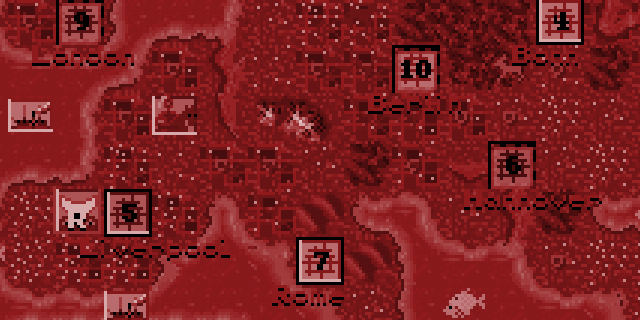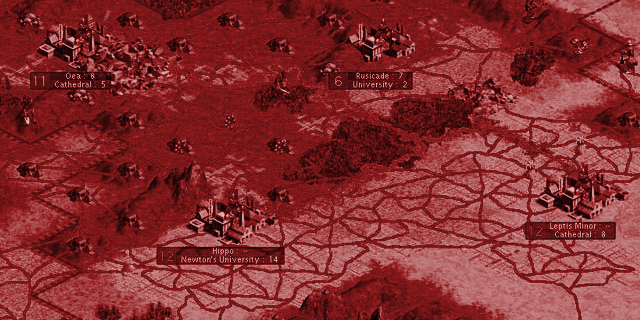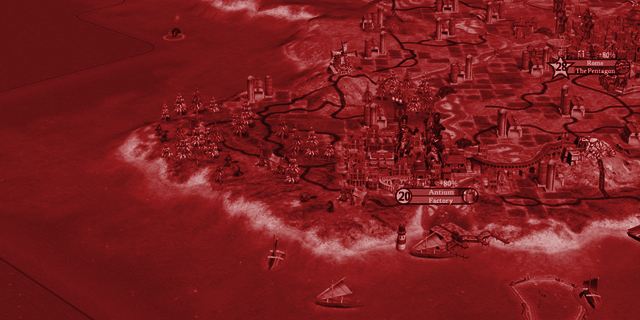
In From Pixels to Polygons, we examine classic game franchises that have survived the long transition from the 8- or 16-bit era to the current console generation.
This series is about standing the test of time, and the adaptations a series must make to do it. For Civilization, how could it not? Adaptation, progress and making prudent advancements is exactly what you learn from playing Civ, and over the past two decades, it’s also proven to be what you learn from making it. Change has certainly come to Civ with each new installment, but there’s something about playing it that is still so true to the original idea.
A new franchise dawns

Board games had a great influence on Sid Meier, so the inspiration from Francis Tresham’s groundbreaking Civilization is impossible to ignore. One of the flagship titles of Avalon Hill, it not only was the first game to have a technology tree, but focused on growing an empire through trading and good diplomatic relationships rather than pure conquest. That makes it the single most important precursor of Sid Meier’s Civilization, even if the connection isn’t acknowledged, probably because of the legal problems surrounding it.
From this base, Meier built a game more specifically tailored to the digital medium, adding fog of war and a higher level of micromanagement, representing whole units in the map instead of abstracting combat and extending the scope from the Bronze Age to the whole history of mankind. He drew inspiration from SimCity, and allowed greater control over the smallest of nuances.
And it worked. Sid Meier’s Civilization became a huge hit, and the sharp edges of the original were removed in Civilization II. Through additional content and actual diplomatic aspects instead of a simple comparison of power, Civilization grew into a multifaceted game ,and the multiplayer aspects that were introduced in CivNet blossomed in its sequel (even if games often devolved into who could build more Howitzers). The gears of progress were turning, and Civilization got ready to run for the long haul. – Erik Twice

A sense of scale
 Civilization III took the motto of “bigger and more complex is better”, a decision that resulted in Civ III games taking longer to complete than any other entry in the series. Mechanics that focused on bigger, more sprawling empires caused unit and building spam that would result in the aptly named “Stacks of Doom” filled with dozens to hundreds of troops that made up every war. One addition that was entirely new was the addition of culture and culture victories. Cities would produce culture which would determine national boundaries, and allow you to culturally overwhelm and peacefully conquer nearby cities belonging to your opponents. It also separated science, luxuries and taxes from government type, allowing players to use any ratio among them without having to change governments.
Civilization III took the motto of “bigger and more complex is better”, a decision that resulted in Civ III games taking longer to complete than any other entry in the series. Mechanics that focused on bigger, more sprawling empires caused unit and building spam that would result in the aptly named “Stacks of Doom” filled with dozens to hundreds of troops that made up every war. One addition that was entirely new was the addition of culture and culture victories. Cities would produce culture which would determine national boundaries, and allow you to culturally overwhelm and peacefully conquer nearby cities belonging to your opponents. It also separated science, luxuries and taxes from government type, allowing players to use any ratio among them without having to change governments.
A series of licensing squabbles in the mid-’90s resulted in Activision publishing Civilization: Call to Power and Call to Power II, marketed at the time as the follow-ups to Civilization II. Many aspects of these games were overlooked by the Sid Meier-led core series, though some features such as plunderable trade routes, offensive non-military units(like slavers or televangelists) and future technology units have shown up in Civilization IV and V. Perhaps the most notable aspect of the Call to Power series was the vast future era it created. Advance far enough, and you could build an entire undersea empire or create a web of space colonies and bomb your enemies into the Stone Age.
After Civilization: Call to Power was released, Activision lost its license to the name, leading this short-lived offshoot of the series to an early death when Call to Power II failed commercially without the Civilization name attached to it. – Shawn Vermette

You want a revolution?
 Civ IV really moved the franchise forward, in almost every way. Civilization III had focused on complexity and big empires, and IV reined that in a little bit. The biggest change: the importance of resources and terrain. Big empires were still viable, but the game encouraged smarter city placement. To diplomacy, it brought religion as an engine to drive diplomatic maneuvering. Unfortunately it proved to drive it a bit too well, and players simply abused it to trivialize the diplomacy system. (Beyond the Sword tried to alleviate this slightly.)
Civ IV really moved the franchise forward, in almost every way. Civilization III had focused on complexity and big empires, and IV reined that in a little bit. The biggest change: the importance of resources and terrain. Big empires were still viable, but the game encouraged smarter city placement. To diplomacy, it brought religion as an engine to drive diplomatic maneuvering. Unfortunately it proved to drive it a bit too well, and players simply abused it to trivialize the diplomacy system. (Beyond the Sword tried to alleviate this slightly.)
Civilization IV added many of the features we now take for granted, and allowed for partial automation of the more mundane tasks, such as managing the tiles worked by a city. It also added Civics in place of specific government types, allowing the player to customize their policies in several different areas, each having its own set of advantages and disadvantages. Civilization IV brought the franchise forward, but it retained a lot of old mechanics that held the game back. War was still an economics game, and winning was simply a matter of outgrowing and outproducing rivals, yet units could promote, and protecting your units offered significant advantages.
Alongside Civ IV came Civilization Revolution. This was the first big foray into console gaming for the franchise. Revolution lacked the depth of the PC games, but it did retain a lot of the things that make Civ great. In appearance, it was very similar to Civilization IV, though it removed a lot of tasks that were primarily mouse-driven. It’s probably still one of the easiest games in the franchise to pick up and play, especially if you’re playing online. However, the time required for each player to take a turn sequentially led to games feeling slow, especially for a console audience. – Jeff deSolla

A multifaceted approach
 While Civ IV‘s expansions and Civ Rev were full of experiments and untested game ideas, Civ V seems like the effort to pick the very best of these innovations and integrate them back into the core product. The game’s easier to play, learning the lessons from Revolution to make processes more intuitive. The diplomacy system is much more nuanced now, and the addition of autonomous city-states adds the extra wrinkle it needed. The visuals are refined to look much more natural than its predecessors, though you can be sure that it was designed to degrade and run on whatever semi-recent system players could get their hands on.
While Civ IV‘s expansions and Civ Rev were full of experiments and untested game ideas, Civ V seems like the effort to pick the very best of these innovations and integrate them back into the core product. The game’s easier to play, learning the lessons from Revolution to make processes more intuitive. The diplomacy system is much more nuanced now, and the addition of autonomous city-states adds the extra wrinkle it needed. The visuals are refined to look much more natural than its predecessors, though you can be sure that it was designed to degrade and run on whatever semi-recent system players could get their hands on.
Mostly, though, Civ V is about tactics. The series has had grand strategy fairly locked down, but it was the moment-to-moment combat that needed work. So in came two innovations: the hex grid and the one-unit-per-tile rule. The latter removed the “Stack of Doom” problem, and the former made sure that encounters had the opportunity for subtlety and creative maneuvering.
Still, it was a rough release for many die-hards, and it took a few patches and expansions to get more and more of these things right. Gods and Kings brought back religion and spies, and did so with some actual thought that made these implementations better. Brave New World, the latest release, focused on culture and trade.
So what’s next for Civ? If history is any indication, expect to possibly see one more expansion before any Civ VI news breaks. Firaxis likes to take its time, and with a successful XCOM, it can likely afford to do so. (It also doesn’t hurt that Civ V doesn’t seem long in the tooth quite yet.) But if we’ve learned anything from the series, it’s that you can’t stem the tide of progress. – Graham Russell

What’s the peak of the Civilization series?
 Erik: Civilization V was rough when initially released, but it had better core mechanics than any other game of the franchise. After many patches and two expansions, it has become downright amazing, going beyond the limits set by previous games.
Erik: Civilization V was rough when initially released, but it had better core mechanics than any other game of the franchise. After many patches and two expansions, it has become downright amazing, going beyond the limits set by previous games.
 Shawn: Civilization V is the peak at this point. When it released, it suffered from feature loss and a poor tactical AI compared to the fully developed Civilization IV: Beyond the Sword, but thanks to its superior design and mechanics, along with three years of fine tuning and expansions, it is now the preeminent entry in the series. Never has One More Turn Syndrome been more enjoyable to suffer from, or more contagious.
Shawn: Civilization V is the peak at this point. When it released, it suffered from feature loss and a poor tactical AI compared to the fully developed Civilization IV: Beyond the Sword, but thanks to its superior design and mechanics, along with three years of fine tuning and expansions, it is now the preeminent entry in the series. Never has One More Turn Syndrome been more enjoyable to suffer from, or more contagious.
 Jeff: Civilization V really was a game changer for me. While I was very impressed with IV, After a couple of games of V, I felt that losing the missing features were worth it. One unit per tile was what sold me on the whole thing: war was well, war again. My units actually mattered, instead of simply being a representation of my civilization’s economy bashing itself against enemy cities. Gods and Kings brought back many of the missing features, and Brave New World refined the entire formula.
Jeff: Civilization V really was a game changer for me. While I was very impressed with IV, After a couple of games of V, I felt that losing the missing features were worth it. One unit per tile was what sold me on the whole thing: war was well, war again. My units actually mattered, instead of simply being a representation of my civilization’s economy bashing itself against enemy cities. Gods and Kings brought back many of the missing features, and Brave New World refined the entire formula.
 Graham: The thing about the Civilization formula is that it doesn’t deal with that much dramatic turnover. Just like civilization itself, with this series, progress is good. So for now? That means Civ V is the current king.
Graham: The thing about the Civilization formula is that it doesn’t deal with that much dramatic turnover. Just like civilization itself, with this series, progress is good. So for now? That means Civ V is the current king.
In our next installment, we’ll hurling red shells and drifting around corners with a look at Mario Kart. For more, check out the archive.



















